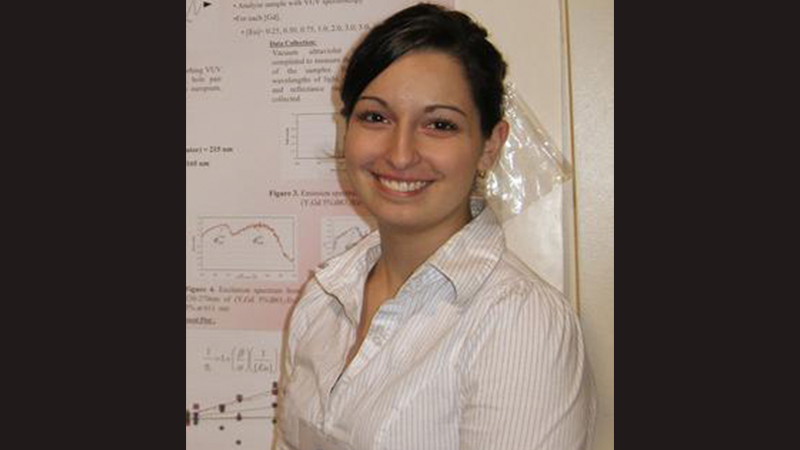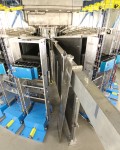A young Oregon State University graduate student has successfully turned her participation in a two-day POWGEN Neutron Diffraction workshop at the Spallation Neutron Source (SNS) into a published paper in the Journal of Solid State Chemistry. Participants at the workshop last September were invited to bring along their own samples for analysis on the time of flight diffractometer. They received training on the instrument and then were taught how to collect and analyze the data, said POWGEN lead instrument scientist Ashfia Huq. “We used the sample changer, which can hold up to 24 samples, and everyone was given two and a half hours worth of time,” Huq said. News of a second paper to emerge from the workshop recently reached her, as well..
Rosa Grajczyk, a second year PhD student in chemistry who is working on structural properties of new materials, brought a sample from the solid solution of indium-gallium-magnesium-oxide (i.e., InGaCu0.60Mg0.40O4) to the workshop. “The InGaCu1-xMgxO4 study is a part of my thesis, which is based on the structure – property relationships of the trigonal bipyramidal site in layered oxide compounds,” Grajczyk explained..
Trigonal bipyramid formation refers to a molecular geometry in chemistry, featuring one atom at the center and 5 more at the corners. In this structure, the bond angles surrounding an atom are not identical, as no geometrical arrangement that can result in five equally sized bond angles in three dimensions. “Substitutions into the trigonal bipyramidal (TBP) crystallographic site of YMnO3 and YbFe2O4-type structures have recently been discovered to have interesting physical properties,” Grajczyk explained. “To further understand the role of this molecular geometry in these compounds, we completed a study of a solid solution of doped The InGaCu1-xMgxO4. We chose this material because it has diverse electronic configurations and similar ionic radii of ions in the TBP site.”.
The trigonal bipyramidal site in oxide materials has not been as well documented as the octahedral or tetrahedral crystallographic sites, Grajczyk said. This class of materials shows a wide variety of useful physical properties, depending on the ions that are substituted into the structure. Researchers must understand the structure-property relationship in order to optimize the properties of these materials, whether magnetic, dielectric, or optical..
“The POWGEN workshop was a great experience that I would highly recommend for other scientists to participate in,” the young researcher said. “The amount of detail that went into the workshop was incredible, which was facilitated by the helpfulness of everyone at the ORNL facility. I feel that the amount of knowledge that I received during the workshop has been extremely helpful to my research. And the contacts that I was able to make during that time will continue to be an asset throughout my career.”.
Before coming to the workshop at SNS, Grajczyk had already done an extensive part of her research on the material, using x-ray diffraction. But neutron diffraction was also necessary to determine how much of each element was in the TBP site, in addition to the other structural parameters of the material..
“The use of neutrons is necessary because of the increased detection of the lighter magnesium and oxygen atoms compared with what can be observed with x-ray diffraction. “POWGEN was useful for collecting these data because of the high intensities that can be achieved by this instrument, while still maintaining the high amount of resolution that is required for our analysis.“.
Their initial x-ray diffraction data showed that when they added magnesium into the material’s structure, the c – parameter, which is relative to the height of the structure, increased. The neutron diffraction data then allowed them to determine the bond lengths of the trigonal bipyramidal site in their sample and to compare these lengths to those of the InGaCuO4 and InGaMgO4 end members. Their findings were accepted last month for publication in the Journal of Solid State Chemistry.
Huq said the workshop included lectures on the basics of time-of-flight neutron diffraction and on the software packages GSAS (General Structure Analysis System) and Fullprof, routinely used for powder diffraction data analysis. Other lectures included analysis of magnetic structures by Vasile O. Garlea of the HB-2A diffractometer at HFIR and by Jülich scientist Olivier Gourdon titled, “From Disorder to Long-Range Order, Jana2006 as a new software tool.”
Funding for this work came from NSF Grant DMR 0804167. Research at Oak Ridge National Laboratory’s Spallation Neutron Source was sponsored by the Scientific User Facilities Division, Office of Basic Energy Sciences, U.S. Department of Energy, under contract DE-AC05-00OR22725 with UT Battelle, LLC.
Published Work
Grajczyk, R., Biswas, K., Berthelot, R., Li, J., Sleight, A. W., and Subramanian, M. A., “Substitutions into the trigonal bipyramidal site of InGaCuO4,” Journal of Solid State Chemistry, 187, 258-263 (2012): http://dx.doi.org/10.1016/j.jssc.2012.01.026.





